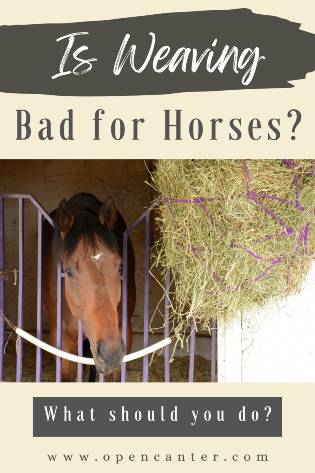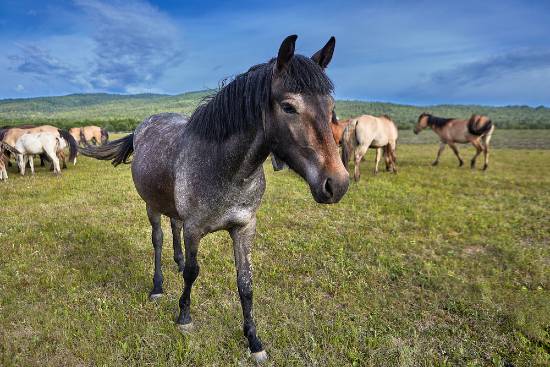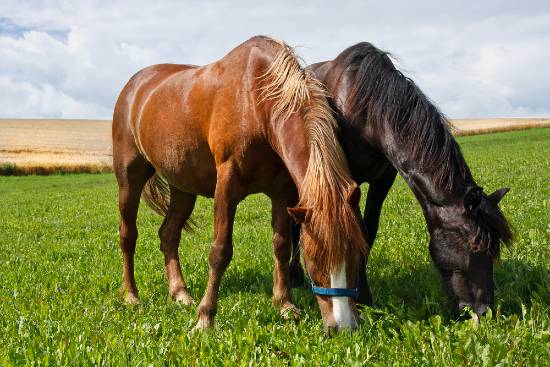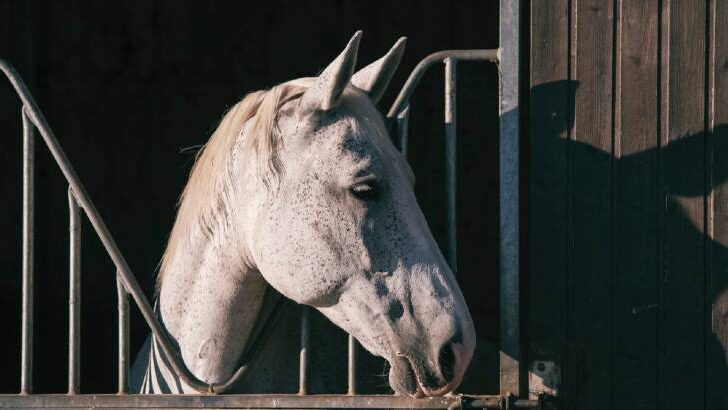Affiliate Disclaimer
As an Amazon Associate I earn from qualifying purchases. It helps me keep the website going. Thank you for your support.
The topic of weaving is a common one amongst the equestrian community. You might have seen adverts of horses for sale stating that the horse weaves. Or you might have seen a horse in your barn who weaves whenever they are stabled. So, what makes weaving bad for horses?
Weaving is a behavior that horses use to cope with their environment. There are two main reasons that make weaving bad for horses. Firstly, repetitive movement can affect joints, ligaments, muscles, and hoof growth. However, more importantly, weaving highlights that your horse is unhappy. Over time, weaving can become a habit that is very difficult to break.
Horses cannot talk; and so, our only insight into how they are feeling is by the physical signs they give us. Read on to learn more about what makes weaving bad for horses.

What is Weaving?
Weaving is when a horse rhythmically sways their head and neck from side to side. This is usually accompanied by the horse shifting weight from one front leg to the other. In extreme cases, the horse may appear to throw itself from leg to leg.
Weaving is classed as an abnormal stereotypic behavior in horses. It is a repetitive behavior that serves the horse no purpose other than to relieve stress or boredom. Horses who weave experience a release of endorphins, ‘feel good’ hormones, whenever they weave.
Domestic horse-keeping practices often involve small fields or the use of stables. This is why weaving is more commonly seen in stabled horses than in those who are kept in large fields. Weaving mostly occurs at a gateway, over a stall door, or facing a wall or fence.
Why Do Horses Weave?
Horses start to weave because they are anxious, frustrated, stressed, or bored. Weaving is a coping behavior that horses developed, similar to crib biting. Weaving is not a deliberate choice made by the horse, but rather a behavior caused by the environment.
Unlike domesticated horses, weaving is not seen in wild horses. Horses are designed to roam and forage for food all day. When horses are kept in stables or small fields, they can become bored or frustrated. Hence, they begin to weave as a way to relieve tension and reduce boredom.
Horses are intelligent and highly social creatures. They were not designed to be kept in stables, small fields, or in isolation. These situations lead to increased boredom and stress. Horses who are kept in this way are much more likely to start weaving.

Horses can also experience separation anxiety when they lose sight of their herd mates. When horses lose sight of their friends, even for a short period of time, it is a highly stressful experience. This can cause the horse who is left behind to start weaving.
There are many other triggers that can be causes for a horse to start weaving. These include frequent routine changes and frequent rotation of stable or herd mates. Lack of activity, visual stimulation, or not enough time to graze are all possible causes.
A common misconception is that horses learn to weave by copying other horses. This is not the case. Horses develop the behavior to help themselves cope with their environment. Some horses are also genetically predisposed to weave. Recent research shows that horses who had a family history of weaving were more likely to become weavers themselves. More research is required to confirm this theory, along with identifying any possible breeds at higher risk. (source)
Why is Weaving Bad For Horses’ Mental Health?
Weaving is a behavior that only starts if a horse is anxious, bored, frustrated, or stressed. This means that the horse who is weaving is unhappy enough to start trying to find a way to cope. If the horse was happy in their environment, they would not feel the need to weave.
As horse owners, it is our responsibility to provide our horses with the best care. Part of this is ensuring the horse is as happy and as healthy as possible. Horses that start weaving are showing you that something needs to change in their environment or routine.
If your horse is unhappy, their overall health will suffer, on top of the ill effects of the weaving itself. A horse who is anxious might not eat or drink enough. This can cause many health issues, stemming from a lack of feed. This includes weight loss, diarrhea, colic, or stomach ulcers.
Some horses, when anxious, sweat excessively. This can lead to severe dehydration, especially when the horse is not drinking enough. Anxiety can also cause muscle tension and trembling.

Horses who are consistently stressed can be hard or even dangerous to handle. They are often spookier than most other horses, as they are on constant high alert. If they are being ridden, their focus and ability to learn will be reduced.
The act of weaving itself causes the release of endorphins, which make the horse feel happy. However, this does not mean that weaving is good for a horse’s mental health. As stated earlier, horses only start weaving when they are stressed or unhappy.
This is why it is important to look after our horse’s mental well-being. If your horse is unhappy, there are a number of impacts this has on your horse’s overall health.
Why is Weaving Bad For Horses’ Physical Health?
The repetitive nature of weaving means that it can have some impacts on a horse’s physical health. Depending on how vigorously the horse weaves, will alter what effects are seen and how severe they are.
Generally, horses who do not weave often, for very long, or very vigorously, don’t experience many side effects. However, horses who weave for long periods of time are at greater risk. Some horses weave so vigorously they appear to throw themselves from side to side!
Weavers may suffer from uneven hoof wear, arthritis, or muscle or ligament strain. Like with any repetitive movement, there is extra wear and tear on muscles and joints. Particularly affected at the joints and muscles of the neck, back, and forelegs.
Horses who weave may also suffer from weight loss or poor performance. However, this is likely a physical effect resulting from the horse’s poor mental health. However, horses will expend extra energy when weaving, and this can contribute to weight loss.
Can I Stop a Horse From Weaving?
It is possible to stop a horse from weaving, but success depends on how long the horse has been weaving. Because it is a coping mechanism, eventually it becomes a habit that the horse uses to help itself feel better.
It is very similar to people who bite their nails when they are stressed or bored. If the behavior is caught early enough, the person has not developed a habit. However, if the person has been biting their nails for months or years, it has become habitual.
This means that the person will turn to biting their nails without really thinking about it. The moment they feel anxious or bored, they will turn straight away to biting their nails for relief. Horses who weave are the same.
Breaking the habit can take time; or in some cases, it can be impossible. Some horses who weave can live permanently outside in a large field with herd mates and still weave. However, the amount of time the horse spends weaving is likely to be minimal. You can read more about horses that weave in the field here.

Is Weaving The Only Behavior That is Bad For Horses?
Weaving is not the only stereotypical behavior that is bad for horses. The other most common behaviors include crib biting and windsucking. These two behaviors are very similar, and both cause the release of endorphins, similar to weaving.
Both behaviors involve the horse swallowing air down into their stomach. Horses who crib latch their top teeth onto a solid object and then pull and swallow air. The horse who windsucks completes a similar air gulping action, but without biting onto an object.
Horses can also engage in self-mutilation behaviors. This means the horse nips or bites at its own flanks, limbs, chest, or girth area. They may also kick themselves with their hind legs. This is perhaps the most serious of all stereotypical behaviors as the horse is causing harm to itself. (source)
Like weaving, these behaviors develop over time and stem from the same causes. What makes horses choose one stereotypical behavior over another is not known.
Some horses also paw the ground with their front hooves excessively, which can be a damaging and annoying behavior. This is not classed as a stereotypical behavior as it doesn’t cause the release of stress-busting hormones for the horse. It is likely more of an indicator that your horse is feeling impatient or uncomfortable at that moment.
Final Thoughts
There are a number of different reasons that make weaving bad for horses. Weaving can have negative health impacts, but it points to a larger issue – your horse is unhappy. Horses only start to weave because they feel unhappy in their environment and are using weaving as a coping mechanism. Making sure your horse has plenty of feed, turnout, socialization, and routine will help prevent your horse from weaving.




